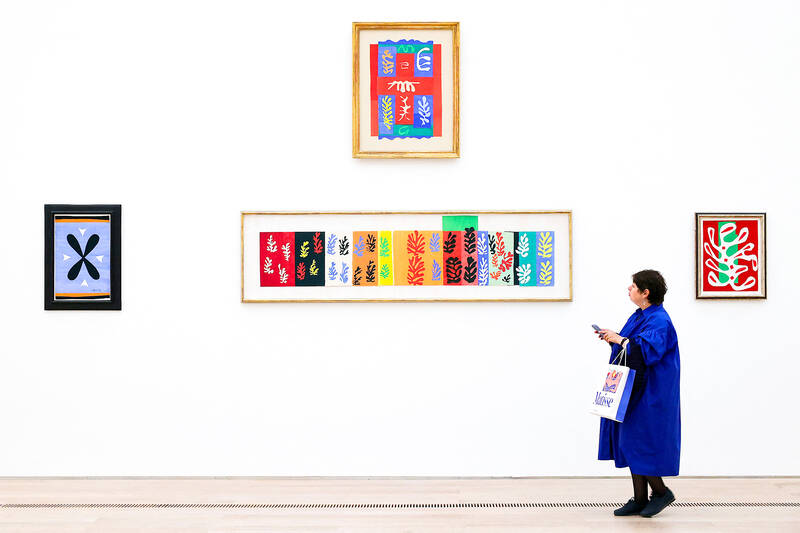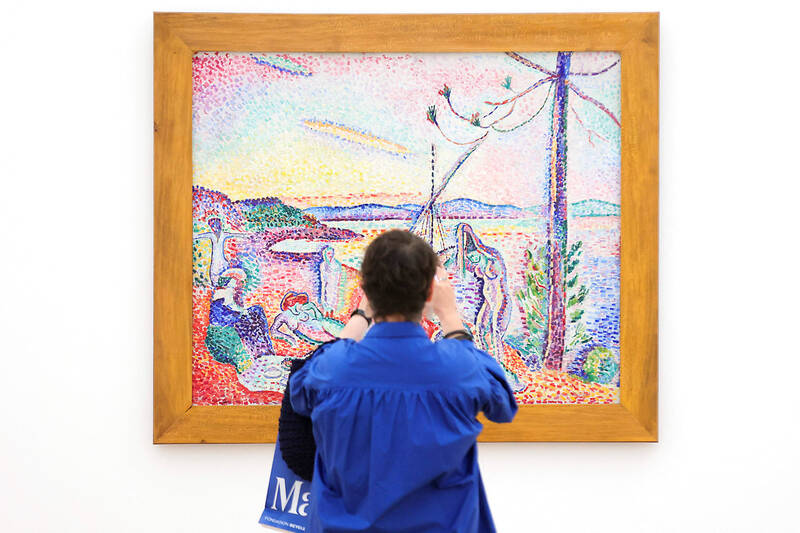A new Henri Matisse retrospective in Switzerland offers visitors a rare chance to follow his artistic journey via works from throughout the career of one of modern art’s godfathers.
The Fondation Beyeler museum on the outskirts of Basel has brought together 72 works by the French artist, who died in 1954 aged 84.
They include paintings, sculptures and cut-out paper collages from major international museums and private collections, some of which have not been seen in Europe for more than three decades.

Photo: AFP
The exhibition is the first Matisse retrospective in Switzerland and the German-speaking world in almost 20 years.
OPEN INVITATION
The “Matisse — Invitation to the Voyage” exhibition is named after Charles Baudelaire’s poem, from which the artist took the phrase “Luxe, Calme et Volupte” for the title of his pivotal 1904 oil painting.

Photo: AFP
“The invitation to travel expresses in a particular way the quintessential aesthetic of Matisse,” said the exhibition’s curator Raphael Bouvier, noting that the painter referred to Baudelaire’s poem “several times in his artistic work.”
Travel is an “essential subject” in his life, with Matisse having worked and drawn inspiration in the south of France, Tangiers, New York and Tahiti.
“The exhibition as a retrospective is really conceived as an invitation to voyage into the work of Henri Matisse,” Bouvier said.

Photo: AFP
It traces the artist’s footsteps from his beginnings in Paris to Collioure in southwest France, where he began to revolutionize art in his Fauvism period “by liberating color,” Bouvier said.
It continues up to his late period, inspired by memories of his trip to the South Pacific.
BLUE NUDES
Towards the end of his life, after undergoing abdominal surgery for cancer, Matisse turned to paper cut-out collages, with the birds and seaweed inspired by the fauna and flora he observed during his trip to Tahiti in 1930.
Matisse occupied a special place in the collection of Ernst Beyeler, the Basel art dealer and collector behind the museum.
A bookseller in his early days, Beyeler launched himself into the art market by selling Japanese prints in his shop before transforming it into a gallery in the early 1950s, where Pablo Picasso and Matisse featured prominently.
Beyeler, who died in 2010 aged 88, particularly liked Matisse’s late works because he saw a “great artistic revolution” in paper cut-outs, said Samuel Keller, the foundation’s director.
The exhibition notably covers his iconic Blue Nudes” cut-out series.
‘COMPLETE PICTURE’
Though Matisse exhibitions regularly cover certain aspects of his work, retrospectives of his entire career are “more rare,” Keller said.
In 2020, the Centre Pompidou in Paris dedicated a major exhibition to the artist, but it was disrupted by the COVID-19 pandemic and its lockdowns, meaning relatively few people saw it.
“With major artists like Matisse or Picasso, we could put together many different exhibitions because there are so many aspects to their work,” for example focusing on the 1930s, or the paper cut-outs, Keller said.
“But in each generation, it is important that the public has the chance to see a retrospective, to have a complete picture of the development from young artist to old master.”
The exhibition runs until Jan. 25.

On April 26, The Lancet published a letter from two doctors at Taichung-based China Medical University Hospital (CMUH) warning that “Taiwan’s Health Care System is on the Brink of Collapse.” The authors said that “Years of policy inaction and mismanagement of resources have led to the National Health Insurance system operating under unsustainable conditions.” The pushback was immediate. Errors in the paper were quickly identified and publicized, to discredit the authors (the hospital apologized). CNA reported that CMUH said the letter described Taiwan in 2021 as having 62 nurses per 10,000 people, when the correct number was 78 nurses per 10,000

As we live longer, our risk of cognitive impairment is increasing. How can we delay the onset of symptoms? Do we have to give up every indulgence or can small changes make a difference? We asked neurologists for tips on how to keep our brains healthy for life. TAKE CARE OF YOUR HEALTH “All of the sensible things that apply to bodily health apply to brain health,” says Suzanne O’Sullivan, a consultant in neurology at the National Hospital for Neurology and Neurosurgery in London, and the author of The Age of Diagnosis. “When you’re 20, you can get away with absolute

May 5 to May 11 What started out as friction between Taiwanese students at Taichung First High School and a Japanese head cook escalated dramatically over the first two weeks of May 1927. It began on April 30 when the cook’s wife knew that lotus starch used in that night’s dinner had rat feces in it, but failed to inform staff until the meal was already prepared. The students believed that her silence was intentional, and filed a complaint. The school’s Japanese administrators sided with the cook’s family, dismissing the students as troublemakers and clamping down on their freedoms — with

As Donald Trump’s executive order in March led to the shuttering of Voice of America (VOA) — the global broadcaster whose roots date back to the fight against Nazi propaganda — he quickly attracted support from figures not used to aligning themselves with any US administration. Trump had ordered the US Agency for Global Media, the federal agency that funds VOA and other groups promoting independent journalism overseas, to be “eliminated to the maximum extent consistent with applicable law.” The decision suddenly halted programming in 49 languages to more than 425 million people. In Moscow, Margarita Simonyan, the hardline editor-in-chief of the